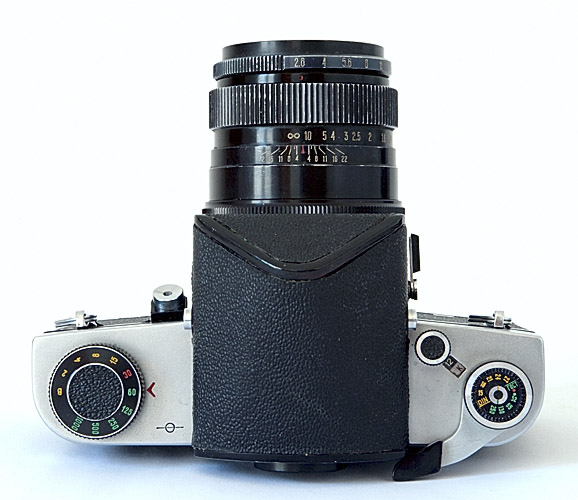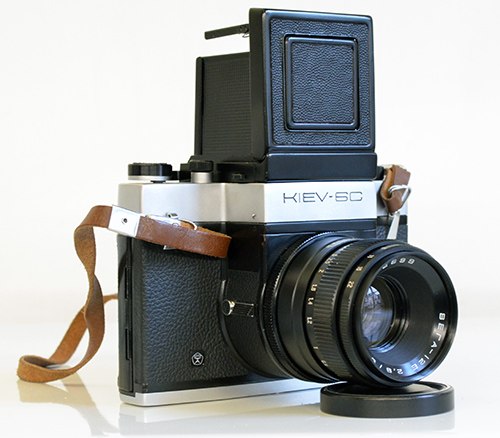by TRA
The History of the Pentacon Six
The Kiev 6C
Dates: c. 1970
(prototype); c.1971-c.1986
(information from
Princelle, p.225)
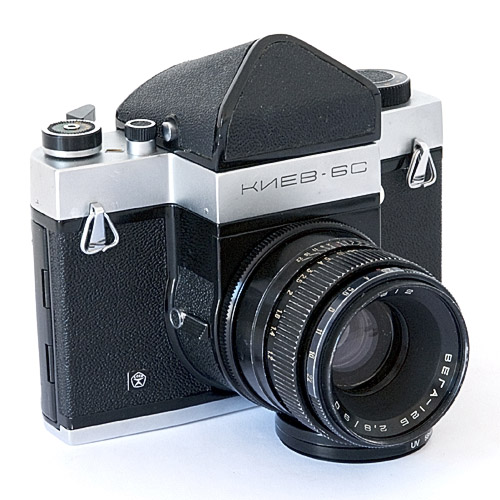
The Kiev 6C with the plain prism.
The horizontal lever on the camera throat is used to
stop down the lens aperture to check depth of field.
This explains why many Arsenal lenses do not have their
own depth-of-field lever.
[6c_3.jpg]
Features
This camera was made by the Arsenal company in Kiev, which since about 1947 had been manufacturing the pre-war German Contax II and III 35mm rangefinder cameras, which had been re-named “Kiev”.
The Kiev 6C clearly had some degree of
inspiration from the Praktisix or Pentacon Six, and
adopted the same lens mount. Note that “C” is the
Cyrillic alphabet equivalent of Roman alphabet “S”, so
the camera is sometimes described as “6S”. It is stated by some
that this “C” (“s”-sound) was a reference to the lens
mount of the Pentacon Six.
Some Kiev 6C cameras did have the camera name in letters of the Latin alphabet (new information received in January 2022, see below). However, I am not aware of any examples of the name plate with a Roman alphabet “S”.
| Unlike the
Praktisix and Pentacon Six, there are no
projecting spool holder “feet” under the body –
but the fact that the spool holder levers are
recessed within the base merely makes the camera
taller than the Pentacon Six. The Pentacon
Six has the tripod socket under the “throat” to
which the lens is attached (the front half of
the mirror box), so a camera case bolt can be
used (without the case) to provide a third foot,
allowing the camera to sit horizontally on a
flat surface. In the Kiev 6C the tripod
socket is in the camera base, so no such
solution is possible, which is why in these
photos the front of the camera has been placed
on a (non-original) filter and lens cap.
With many lenses, the Pentacon Six and Praktisix
balance better on a tripod than the Kiev 6C.
The camera had strap lugs that
were better placed than on the Praktisix and
Pentacon Six (although those cameras were
usually supplied with a case which had its own
strap). The lugs had a hole to accept
standard triangular metal strap connectors
(visible in the photo to the right), which
were supplied as standard. Another oddity was that on the Kiev 6C the shutter release had to be operated by the left hand. The camera took 120 and 220 film and had a two-position pressure plate to allow for the different thickness of the two films (220 film does not have backing paper apart from at the beginning and end of the film). This shows a remarkable attention to detail and the desire to ensure that the film was both as flat as possible and in exactly the right position to give the sharpest-possible image. This was not to be seen again on a camera with the Pentacon Six mount until the introduction of the Exakta 66 in West Germany in 1984. The camera was supplied with a 90mm f/2.8 Vega-12B lens with an automatic diaphragm. (Russian b. For the difference between “B” and “V” lens mounts, see here.) There was a flash sync socket on the front of the camera. The camera was usually supplied with a folding “waist-level finder”, but a non-metering prism was available, and subsequently a metering prism. The Kiev 6C was a lot bigger, heavier and noisier than the Praktisix and the Pentacon Six. It was supplied with a large leather outfit case, initially brown, although later cases were apparently black. |
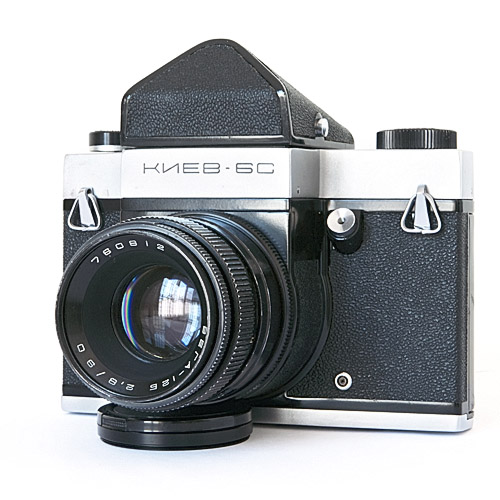 This particular body was made in 1977, and the lens (originally supplied on another camera) in 1976. [6C_1.jpg] |
| The Kiev 6C had both 120 film
(12 exposure) and 220 film (24 exposure)
capability.
A film speed reminder dial on the right of the camera top plate showed film speeds in the Russian GOST and European DIN scales
|
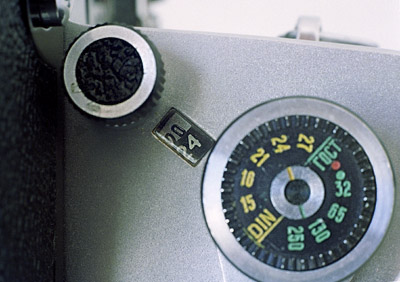 The knob top-left in this picture switches between 120 film (12 exposures) and 220 film (24 exposures). In this image, the camera is set for 24 exposures, and the film is on its 20th frame. [C396_35.jpg] |
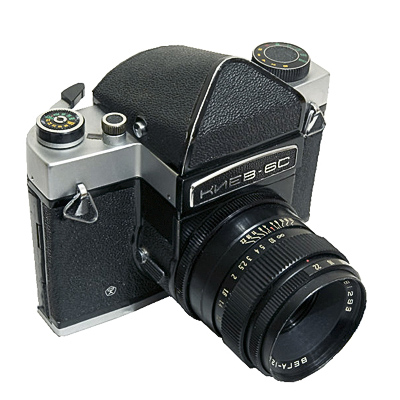 1981 version of the Kiev 6C |
The camera in the above illustrations was made in
1977.
Later versions of the Kiev 6C had a different name-plate, as illustrated here in a camera from 1981. This became the name-plate style that was adopted when the replacement model, the Kiev 60, was introduced. |
| Update
in 2022 In January 2022 the following was received from Mael in France: “Additional information:
Thank you, Mael, for this information and for photos of your camera! |
Export version
of the Kiev 6C
Photograph courtesy of Mael Bilquey Mael comments: “manufactured in 1977. (Leatherette is not original, having been replaced with genuine leather.)” Clicking on this image opens a larger copy. [K6Cexport2s.jpg] |
To go to the Bibliography, click here.
To go on to the next section, click
below.
30 The Kiev 60
To go to the beginning of the history section, click here.
To go to introduction to the cameras, click here.
To choose other options, click below.
Home
© TRA June 2010, Revised January 2022
